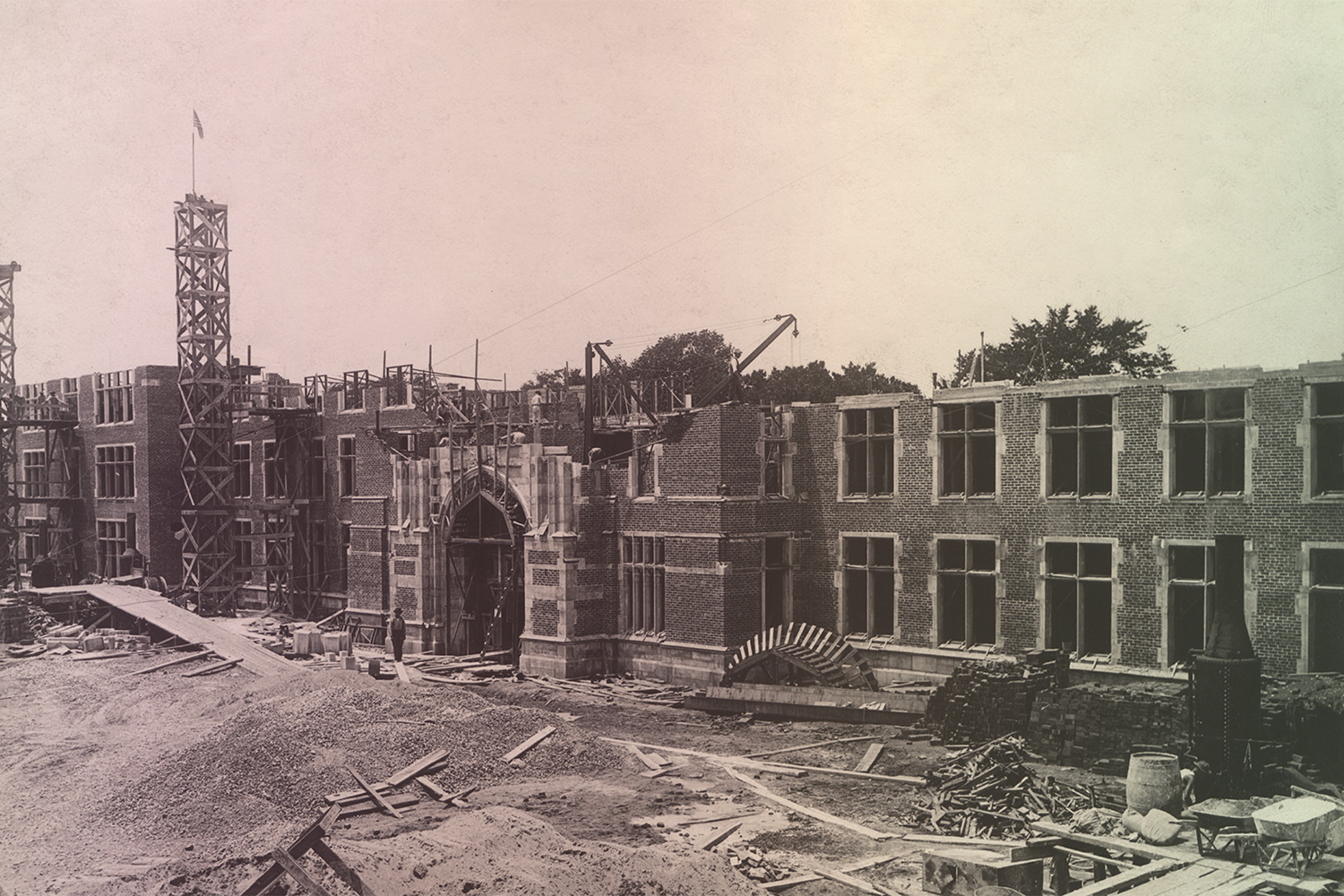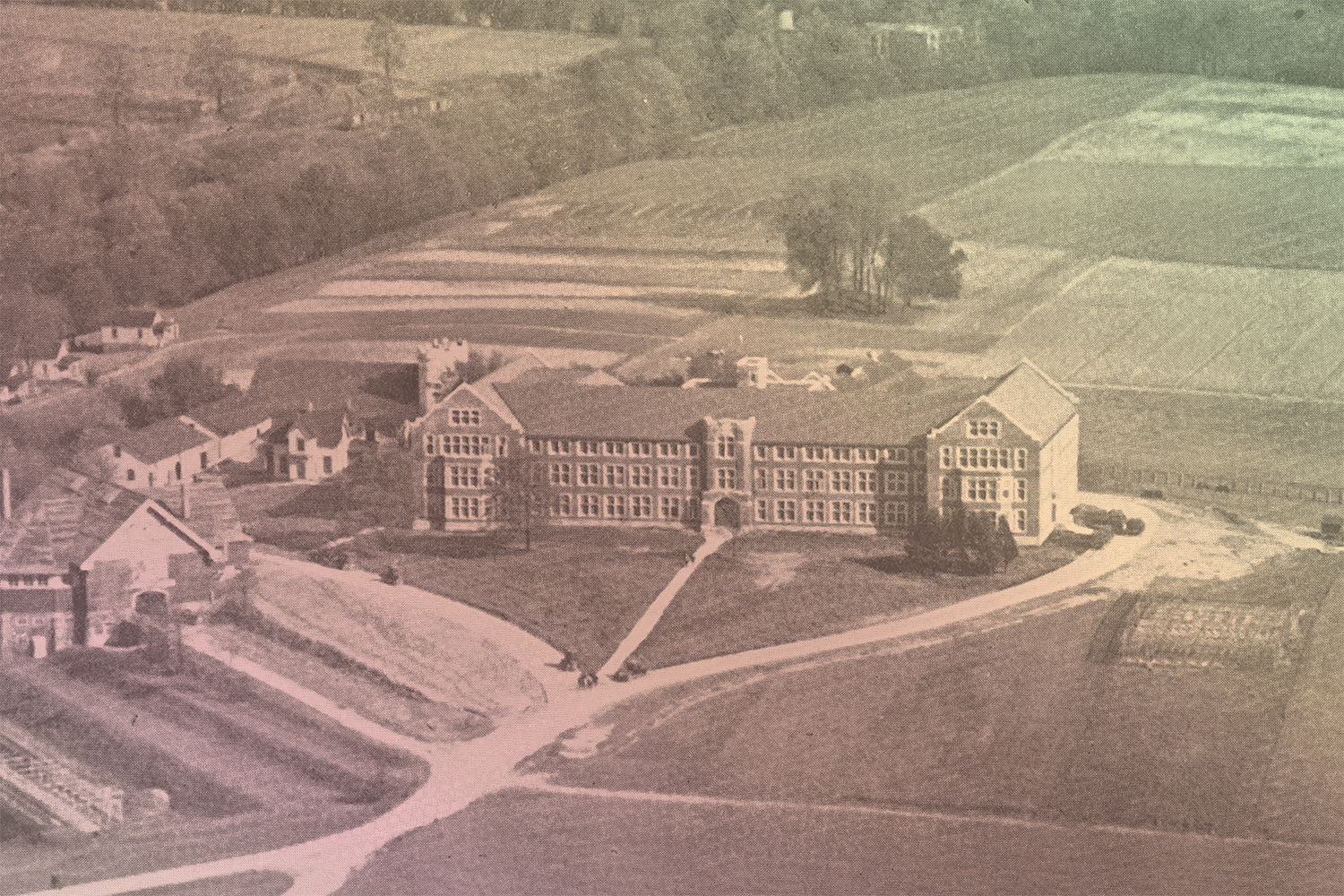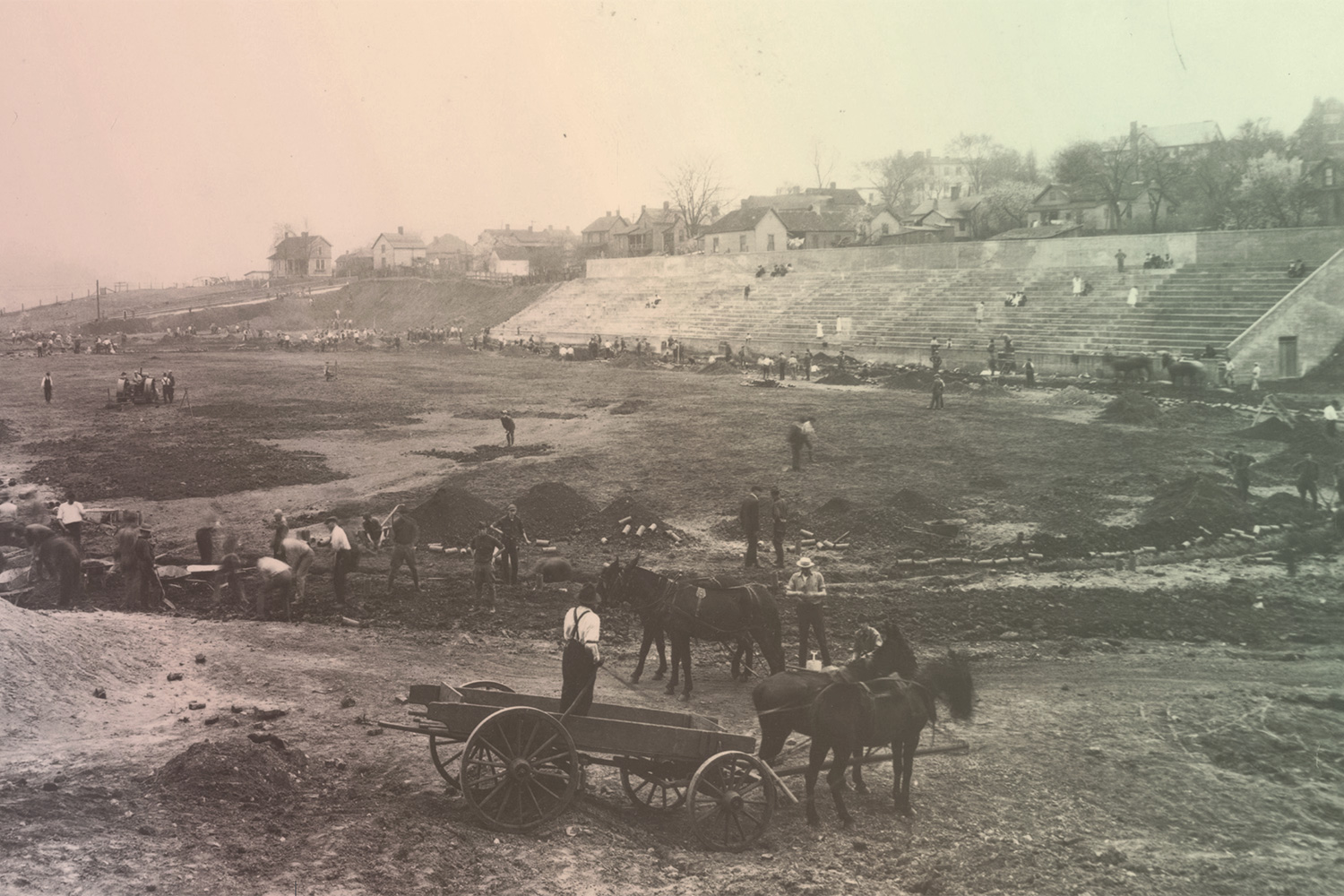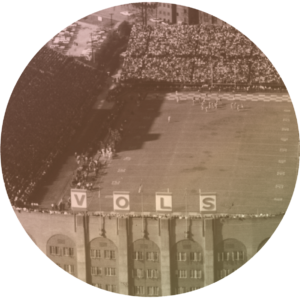Celebrating 100 years of AYRES HALL, MORGAN HALL, and NEYLAND STADIUM
Picture it. Knoxville, June 1921. Campus is bustling with the excitement of commencement week and the dedications of two grand new academic buildings: one crowning the Hill and becoming a symbol of the university, and the other nestled near the river, solidifying UT as one of the country’s agricultural leaders. And just a few months earlier, another area of campus—one that would come to be known for touchdowns and cheering fans—was christened by the crack of a baseball bat. Take a look at some interesting and unusual facts surrounding three campus icons celebrating their centennials this year: Ayres Hall, Morgan Hall, and Neyland Stadium.
Ayres Hall

In 1917, UT was given a $1 million bond from the State of Tennessee, which included $800,000 to add academic buildings to the growing campus. Planning for a building to replace the Old College, West College, and East College buildings on the Hill began but was hampered by the United States entering World War I.
UT President Brown Ayres, who had been key in securing the bond and had the vision of a great academic building on the Hill, spent part of his last day in office before his sudden death in January 1919 trying to find a way to preserve Old College—the oldest structure on the Hill, finished in 1828.
A plan by alumni to raise $15,000 to move Old College had failed, and it was discovered that the interior walls had been constructed with soft brick, making the building too dangerous to move.
Following the demolition of the three buildings, 15,000 cubic yards of graded soil was used to level out what would become Shields-Watkins Field.
In November 1919, student Blanche Bingham laid the inaugural brick for Ayres Hall, which had been saved from Old College.
On March 26, 1920, a cornerstone of white marble was set in the center of the southeast side of the building. Under the stone was a box containing a picture of Old College, a copy of the $1 million legislative bill, a UT catalog, and various other publications.
Ayres was built in the Elizabethan Revival style—a mixture of classicism and Gothicism—which was a cost-saving measure.
The building was originally meant to have two small towers at each end, but they were cut to save money.
The total cost of the structure, which included expansion of the heating plant and equipping the building, was $689,500 (the equivalent of $10.5 million in 2021).
Steam pipes from a new boiler room in Estabrook Hall had to be run to Ayres. During the digging of a trench for the pipes, six skeletons were found below the driveway just west of Barbara Blount Hall. The remains were believed to be those of Union soldiers killed in Knoxville during the Civil War.
More than 2,500 people came to the dedication of Ayres Hall on June 7, 1921. The ceremony was presided over by alumnus Philander Claxton, who at the time was serving as US commissioner of education.
Until recently, the name Ayres was misspelled on the tower’s plaque as Ayers. The grandson and namesake of President Brown Ayres asked that the mistake be rectified. In 1992, the family paid for an additional plaque with the correct spelling, which is mounted beside the original.
Morgan Hall

The cornerstone for the new agricultural building was laid on November 1, 1919, during Homecoming. Among items placed in a box in the stone were UT publications, photos of recently deceased President Brown Ayres and then President Harcourt Morgan, and a copy of the appropriations bill that funded the building.
Also included in the box was a history of the trowel used by President Morgan’s son, Harcourt Morgan Jr., to lay the cornerstone. The trowel was made from remains of Old College, which had been torn down to make way for Ayres Hall.
The building is three-and-a-half floors, 150 feet long by 100 feet deep. Tapestry bricks were used for the facing and white Bedford stone for the trim.
The agricultural building was completed a few months before Ayres Hall at a cost of about $265,000 ($4.1 million in 2021).
The building’s completion brought UT’s agricultural units together under one roof and established UT as a leading land grant institution, as was evidenced when W. O. Thompson, chair of the Land Grant College Association, spoke at the June 6, 1921, dedication of the building.
Students were so proud of their new building that they decided to host a Barnwarmin’ in the fall of 1921, complete with farm decor and invitations delivered in hollowed-out corn cobs. Barnwarmin’ became an annual event until it was discontinued in 1943 when the club’s membership declined because of World War II.
The building was renamed Morgan Hall on November 13, 1937, in honor of Harcourt Morgan, who had served as dean of agriculture before succeeding Brown Ayres as UT’s president.
A mounted moose head hung at the rear of the building’s original auditorium as a nod to Morgan’s roots in Ontario, Canada.
The original time capsule was removed this year and found to have a small crack in its seal that had caused much of the contents to disintegrate.
A new time capsule was built with the help of engineering students. A list of the contents can be found at tiny.utk.edu/morgan-capsule.
Neyland Stadium

The development of a new athletic field was proposed in 1913 by engineering professor Charles Ferris, who helped form the University Realty Company to purchase four acres of land on Courtney Hill for $26,000 ($718,458 in 2021). It was thought that there would be enough revenue to pay the taxes, insurance, and interest on the mortgages of the houses on the property, but the company was faced with foreclosure more than once.
By 1919, the company was $22,453 in debt and in danger of losing the land until William Shields, a UT trustee and local bank president, paid the debt and gave the land to UT, provided it could match his gift to create the field.
UT raised about $27,000 to meet the obligation, which included $8,000 donated by E. C. Camp.
The field is named Shields-Watkins in honor of Shields and his wife, Alice, whose maiden name was Watkins.
 A professor who would later become dean of the engineering college, Nathan Dougherty, was in charge of designing and grading the field. He had played football for the Vols (1906–09) and is considered by many to be the founding father of UT Athletics.
A professor who would later become dean of the engineering college, Nathan Dougherty, was in charge of designing and grading the field. He had played football for the Vols (1906–09) and is considered by many to be the founding father of UT Athletics.
President Morgan declared a school holiday called Campus Day on March 16, 1921, so students could help prepare the field. About 700 to 800 students and faculty volunteered over two days to complete construction of the new multipurpose field.
The first bleachers were on the west side and could seat 3,200 people in 17 rows. The first game ever played on the field was a baseball game against Cincinnati.
The first football game on the field was September 24, 1921, against Emory and Henry. The Vols won 27–0.
In 1926, General Robert R. Neyland joined the Tennessee football program. On October 20, 1962, a few months after Neyland’s death, the stadium was given his name and dedicated with a game against Alabama.
Now Neyland Stadium holds 102,455 Vol faithful. It’s the fifth largest stadium in the nation and the seventh largest in the world. Watch a video commemorating the stadium’s centennial anniversary at tiny.utk.edu/neyland100. ![]()
Compiled with information from:
UT Libraries Special Collections (information and all photos)
Volopedia
Alumnus
Knox Mercury
About Face: The Coming of Ayres Hall at the University of Tennessee (Justin C. Dothard)
UT Agriculture, Summer 1996, “Celebrations” and “Diamond Anniversary” (Lisa Byerly Gary)
Morgan Hall Centennial Program
UT Athletics


4 comments
These pics are timeless. Stadium is so tall
the shadows are cast that can block the player’s vision when they are on the field.
I have a 1919 UTK annual. Over a hundred years old. Go Vols.
During the football season of 1967 I was a football team manager for the Bristol Tennessee High School “Viking” football team. At the end of the season some alumni paid to take the team to the Tennessee vs Vanderbilt game which the Vols won by about 45 points as I recall. Before the game we were allowed to enter Neyland Stadium by a field level gate just to see it. The Bristol Tennessee High Stadium was large, compared to many other high school stadiums, but I was overwhelmed by the huge size of Neyland Stadium. And since then it has gotten even larger! It is amazing! Home of the Vols as the sign on the huge press box said back then!
As a 10 year old boy – my first game at Neyland Stadium featured Condredge Holloway and the Vols vs Notre Dame in a freshman football game. I was hooked for life!
What was the first game played with the famous VOLS in the South end zone? Had to be around 1968 or so?
Comments are closed.